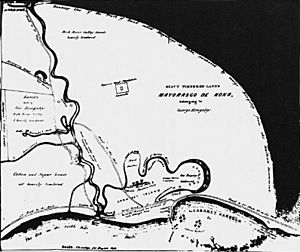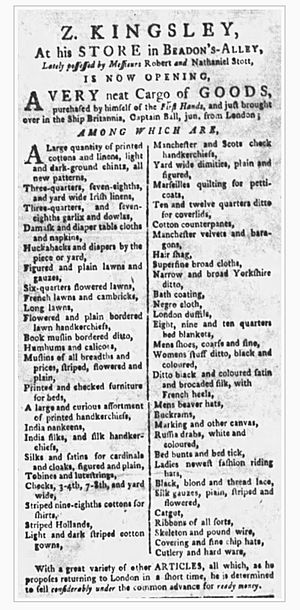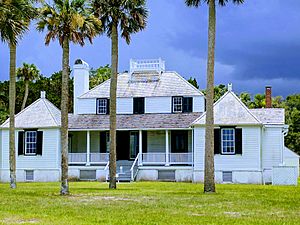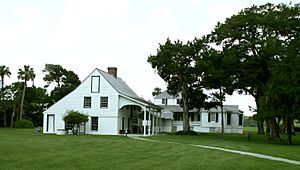Zephaniah Kingsley facts for kids
Quick facts for kids
Zephaniah Kingsley
|
|
|---|---|
| Born | December 4, 1765 |
| Died | September 14, 1843 (aged 77) New York City, US
|
| Citizenship | United Kingdom (1765–1793), United States (1793–1798), Denmark (1798–1803), Spain (1803–1821), United States (1821–1836), Haiti (1836–1843) |
| Occupation | Slave trader, planter |
| Known for | Anti-racist; believed Blacks superior to whites. His wife was an African woman. |
|
Notable work
|
A treatise on the patriarchal, or co-operative system of society as it exists in some governments, and colonies in American, and in the United States under the name of slavery, with its necessity and advantages, 1828 |
| Title | Member Florida Territorial Council |
| Spouse(s) | Polygamous. He had four Black "wives," or concubines, none with a Christian marriage, although he claimed to have married Anna outside the U.S., in an African ceremony. Legal wife (recognized by American courts after his death): Anna Kingsley. Co-wives, or concubines: Flora Kingsley, Sarah Murphy, and Munsilna McGundo (all enslaved at time relationship with Kingsley began) |
| Children | 11, all from Black mothers |
| Relatives | Grandnephew James Whistler |
| Family | Whistler's Mother |
Zephaniah Kingsley Jr. (born December 4, 1765 – died September 14, 1843) was a plantation owner, slave trader, and merchant. He was born in England but moved to South Carolina as a child. He built four plantations in the Spanish colony of Florida, near what is now Jacksonville, Florida.
Kingsley served on the Florida Territorial Council after the United States took over Florida in 1821. His home, Kingsley Plantation, where he lived for 25 years, is now part of the Timucuan Ecological and Historic Preserve. This preserve is managed by the United States National Park Service.
Kingsley was mainly a slave merchant in his younger years. He owned and captained ships that carried enslaved people. He was involved in the Atlantic slave trade. He believed this was a "very respectful business." He was also in favor of slavery, but he treated enslaved people differently than many others at the time. He has been called "a man ahead of his time."
He was a kind slave owner who respected families. He allowed enslaved people to earn money by working extra. They could even buy their freedom for half their market value. Kingsley's main business in Spanish Florida was providing skilled enslaved people. These individuals were often smuggled to planters in Georgia and South Carolina.
Kingsley changed his nationality several times to help his slave trading business. He was born British. In 1793, he became a U.S. citizen. In 1798, he swore loyalty to Denmark. In 1803, he became a citizen of Spain in Spanish Florida. When Florida became part of the U.S. in 1821, he became an American citizen again. President James Monroe even called him "one of the most fit and discreet persons in our territory." At the time of his death, he was a Haitian citizen, which he became in 1836.
Contents
Early Life and Education
Kingsley was born in Bristol, England. He was the second of eight children. His father, Zephaniah Kingsley Sr., was a Quaker from London. His mother, Isabella Johnstone, was from Scotland.
His family moved to the Colony of South Carolina in 1770. Zephaniah Jr. grew up in Charleston, South Carolina. His father became a successful merchant there. At age 15, Zephaniah Jr. was sent to London for his education. His father bought a rice plantation near Savannah, Georgia. He also owned other properties and about 200 enslaved people.
After the American Revolutionary War, Kingsley Sr. and his family had to leave South Carolina. Their properties were taken by the new government. They moved to New Brunswick, Canada, in 1782. The Crown gave him land as payment for his losses. He became a successful merchant again.
Zephaniah Kingsley Jr. returned to Charleston, South Carolina, in 1793. He swore loyalty to the United States. He started a career as a shipping merchant. His first business was in Saint-Domingue (now Haiti) during the Haitian Revolution. He was mainly interested in exporting coffee. He lived in Haiti for a short time. He traveled often because of political problems in the Caribbean islands.
Kingsley's Views on Race
Kingsley was different from other Southern leaders of his time. He believed that Black people were just as smart as white people. He made fun of racism. He said that "color ought not to be the base of degradation."
Kingsley thought that "the colored race" was "superior to us, physically and morally." He said they were healthier and had more graceful forms. He also said they were more loyal and less likely to cause trouble. He believed this was why they could be kept in slavery.
Kingsley said he spoke "several African dialects." When he commanded a slave ship, his crew was made up of Black men. Most of them were enslaved. His farm at Laurel Grove was run by Africans without white people present. It has been called "a transplanted African village."
He supported African customs. He was in favor of "interracial" marriage, which was called "amalgamation" then. He wrote that it produced healthy, beautiful children. He followed his own advice. He had a family with four enslaved African women. He eventually freed all of them. He claimed to have married one of them, Anna Jai, in an African ceremony. He had nine children with these women. All of his children were of mixed race. He made sure his children received good educations. He wanted to make sure they and his partners could inherit his property.
His first partner, Anna Madgigine Jai, was 13 years old when Kingsley bought her in Havana in 1806. He said he married her in an African ceremony. This marriage was not recognized by Christian customs or U.S. law. He freed Anna Jai when she turned 18. He trusted her to manage his plantation when he was away. His children with Anna were his favorites. They grew up in luxury and received excellent European schooling.
As free Black people became less welcome in Florida, Kingsley worried about his family's safety. To protect them, he moved them to Haiti, a country founded by free Black people.
Kingsley and Religion
Kingsley was born a Quaker, but he often spoke negatively about Christianity. In his will, he asked to be buried "without any religious ceremony whatsoever." He did not want any traditional burial rituals.
Kingsley did not want enslaved people to participate in Christian worship. He believed that slave rebellions were caused by Christian preachers. He thought that religion made enslaved people disobedient. He said it made them think stealing from him was fair.
Instead, Kingsley encouraged dancing, merriment, and dressing up. He set aside Saturday afternoons and Sundays for these activities. After their work was done, enslaved people would use their time to grow corn and catch fish. He noted that his marriage to Anna was "celebrated and solemnized by her native African customs," not Christian ones. Many of Kingsley's enslaved people were Muslims. This is suggested by the crescent shape of their cabins and Kingsley's four partners.
Kingsley's Plantations
Laurel Grove
Spain offered land to settlers in Florida. In 1803, Kingsley bought a 2,600-acre farm for $5,300. This farm was called Laurel Grove. It was located where the city of Orange Park is today. Kingsley eventually owned about 32,000 acres in Florida. He became one of the wealthiest men in the Territory.
Kingsley arrived with 10 enslaved people and started farming. The plantation grew oranges, sea island cotton, corn, potatoes, and peas. By 1811, he had 100 enslaved people at Laurel Grove. He trained them in farming and other skills. This included blacksmithing, carpentry, and cotton ginning. This allowed him to sell them for 50 percent more than the usual price. Many of his enslaved people were sold to planters in Georgia and other parts of the Southeast.
In 1806, Kingsley traveled to Cuba. There, he bought Anna Madgigine Jai, a 13-year-old girl from what is now Senegal. He said he married her in an African ceremony in Havana. This marriage was not legally recognized by Spanish Florida or the United States. Kingsley returned with Anna to Laurel Grove. He came to rely on her to manage the plantation when he was away.
In 1811, Kingsley asked the Spanish government to free Anna and their three mixed-race children. His request was granted. The Laurel Grove plantation earned $10,000 in one year. This was a huge amount for Florida at the time. With his earnings, Kingsley bought more land. This included areas near Jacksonville and Drayton Island. After gaining freedom, Anna Kingsley received five acres of land from the Spanish government. She bought enslaved people to help her farm it.
Kingsley was involved in the shipping industry and domestic slave trading. In 1808, the international slave trade was abolished in the U.S. Kingsley tried to smuggle 350 enslaved people into the country. His ship was caught by the U.S. Coast Guard. The Coast Guard turned the enslaved people over to Kingsley. He was the only one in the area who could care for so many.
The Patriot Rebellion
During a short uprising called the Patriot Rebellion, American forces raided settlements in northeast Florida. They captured enslaved people. In 1813, the Americans captured Kingsley. They forced him to support the rebellion. The rebels took over Laurel Grove. They used it as a base to attack other plantations. Kingsley left the area.
Anna Jai burned the plantation house down so the rebels could not use it. She took her children and a dozen enslaved people to safety on a Spanish gunboat. For her loyalty, Anna Jai received a grant of 350 acres from the Spanish government. Later, Kingsley received $113,410 from the U.S. government for the damages to Laurel Grove.
Fort George Island
After Laurel Grove was destroyed, Kingsley and Anna moved to Fort George Island in 1814. They lived there for 25 years. Their fourth child was born there in 1824.
Kingsley also owned other plantations. These included Springfield, Conesfield, and Drayton Island. He grew many oranges on Drayton Island.
Kingsley had a family with three other enslaved women. He had nine children in total. He eventually freed each of these women: Flora Kingsley, Sarah Kingsley, and Munsilna McGundo. In his will, he named Anna as his wife. Historians consider Flora, Sarah, and Munsila as "co-wives" with Anna. Kingsley cared deeply for all his children. They received excellent European schooling. When visitors came to his Fort George plantation, Anna sat "at the head of the table." They were surrounded by their children.
The plantation had a main house and a two-story building called the "Ma'am Anna House." This building had the main kitchen on the ground floor. Anna and her children lived on the second floor. This was a custom among the Wolof people.
Kingsley was a very wealthy man. His estate was valued at $77,300 after his death in 1843. His plantation was very successful. It produced crops worth $10,000 in one year. The plantation grew oranges, cotton, indigo, and other vegetables. About 60 enslaved people worked there. They worked under a "task system." Each person had a set amount of work to do each day. Once finished, they could use their time as they wished. Some enslaved people had personal gardens. They were allowed to grow and sell vegetables from them.
Thirty-two cabins were built for the enslaved people. They were made from tabby, a durable and inexpensive material. The cabins were about a quarter of a mile from the main house. Enslaved people were allowed to padlock their cabins. They could also build porches facing away from the main house. These features were unusual for slave quarters in the antebellum South.
Kingsley was a lenient slave owner. He wrote that he never interfered with their family lives. He let them manage their own affairs. He taught them only what he thought was useful. He encouraged dancing and merriment. He said they were "perfectly honest and obedient." He rarely had to punish them. He believed owners should treat enslaved people like family members.
Changes Under a New Government
Florida became part of the United States in 1821. The Florida Territorial Council began to set up an American government. This government focused on giving land to new settlers. It also aimed to remove the Seminole people. Americans settled in north Florida and built plantations. They used enslaved labor.
The American system was different from the Spanish system. The American system had two main groups: white and Black. The Spanish system had three groups: whites, free people of color, and enslaved people. Spanish law recognized "interracial" marriages. It allowed mixed-race children to inherit property.
In 1822, President James Monroe appointed Kingsley to the new Council. Kingsley was asked to join a committee. This committee was to discuss laws for enslaved people and free people of color. Kingsley believed Florida should be open to free people of color. He thought they should have some rights, even if fewer than white people. He argued that it was important for free people of color to support good order.
When Kingsley realized the Council would not agree to rights for free Black and mixed-race people, he resigned. By the 1820s, strict laws separating races were passed. Kingsley worried about his family's future. He feared they might not be able to inherit from him.
Kingsley's Treatise
To address these issues, Kingsley published a pamphlet in 1828. It was called A Treatise on the Patriarchal or Co-operative System of Society. The first edition was published without his name. Later editions included his name and stated he was a "slave owner." He said his goal was to increase the value of his property. The pamphlet was reprinted several times, showing many people read it.
In his pamphlet, he wrote that slavery is a necessary form of control. He said it applies to all parts of society. He believed that slavery was wrong when it involved cruelty. But he thought it was acceptable when it was kind and fair.
He also wrote that Africans were better suited for labor in hot climates. He claimed they were happier when strictly controlled. He believed mixed-race people were healthier and more beautiful. He saw mixed-race children as a way to prevent future race conflicts.
His pamphlet received mixed reactions. Some Southerners used it to defend slavery. Others thought his support for free Black people might lead to ending slavery. Abolitionists thought his arguments for slavery were weak. They believed his ideas should lead to slavery being abolished. Lydia Maria Child, an abolitionist, listed Kingsley as someone who supported the "evils of slavery."
Kingsley's pamphlet may have hurt his reputation in Florida. He became involved in a political disagreement with Governor William DuVal. The governor criticized Kingsley's motives and his mixed-race family. Kingsley had asked President Andrew Jackson to remove DuVal from office.
Haiti

Kingsley tried to convince Florida's new government to protect the rights of free people of color. He wanted his mixed-race children to inherit his property. But he began to think that the independent country of Haiti would be better. Haiti's government was inviting free Black people from across the Americas to settle there. They offered land and citizenship.
Kingsley praised Haiti in his pamphlet. He wrote that Black people were "safe, permanent, productive and growing property." He said they were "easily governed" and "less troublesome." He believed they had better moral character than many white people of similar status.
Kingsley was determined to create the society he wrote about. He was worried that his marriage to Anna might not be recognized in the U.S. He feared that his other partners and mixed-race children might be enslaved after his death. To prevent this, he moved to Haiti.
In 1835, Kingsley's son George and six enslaved people went to Haiti to find land. They found a good location on the northeastern shore. This area is now in the Puerto Plata Province of the Dominican Republic. Kingsley bought a plantation called Mayorasgo de Koka. More than 50 formerly enslaved people from Fort George Island worked there. In Haiti, they worked as indentured servants. They would earn full freedom after nine years. Over the next two years, Kingsley moved to Haiti with most of his family. Two of his daughters stayed in Florida because they had married local white planters.
Haitian law at the time did not allow non-citizen white people to own land. So, Zephaniah held Mayorasgo de Koka in the name of his eldest son, George Kingsley.
Death and Property Disputes
In 1843, Kingsley visited his family in Haiti. Then he boarded a ship to New York City for business. He died on the ship from a lung disease at age 78. He was buried in a Quaker cemetery in New York City. This was despite his will asking for no religious ceremony.
Kingsley's will was very unusual. It stated that he knew it was against laws to marry a person of color. But he said it was his property and his business. He also wrote that his African wife, Anna, was one of the finest women he knew. He believed that mixing white and Black races was best for America. He left much of his land to his partners and children.
His white relatives immediately challenged his will. Kingsley's niece, Anna McNeill Whistler (known as Whistler's Mother), tried to prevent his family of African descent from inheriting. Kingsley's will also said that no remaining enslaved people should be separated from their families. They should also be allowed to buy their freedom for half price.
Anna Madgigine Jai returned to Florida in 1846. She fought Kingsley's white relatives in court in Duval County. She won her case. This was a remarkable achievement, as Florida laws were against freed Black people. The court records from this case are almost the only information we have about Kingsley's life in Florida.
After a short time in Florida during the U.S. Civil War, Anna Jai moved to New York. She supported the Union. After the war, she returned to Florida. Anna Madgigine Jai died in April or May 1870. She was buried in an unmarked grave in Jacksonville.
After the Civil War
The Fort George plantation was sold soon after Kingsley's death. After the Civil War, the Freedmen's Bureau controlled the island. In 1869, another planter bought it. The island changed private owners until 1955. Then, the Florida Park Service bought it. Kingsley's house, the "oldest standing plantation house in Florida," Ma'am Anna House, and the barn survived. Most of the slave quarters also remained. The National Park Service created the Timucuan Ecological and Historic Preserve in 1988. In 1991, they bought 60 acres of land around the Kingsley Plantation buildings.
Kingsley's Writings
Kingsley's writings are considered "eloquent" by modern scholars. They mainly discussed slavery. He wrote about how it should be managed. He also wrote about how free Black people, in his view, made a country safer. His writings have been collected and edited by Daniel W. Stowell. The book is called Balancing Evils Judiciously: The Proslavery Writings of Zephaniah Kingsley (2000).
The National Park Service has collected many documents by or about Kingsley.
Pamphlets by Kingsley
- Internet Archive text (1829 edition).
- Internet Archive text (1838 edition).
Archived Materials
- The State Library and Archives of Florida has a special section for Kingsley documents. It includes his will and land grants. Other records are found in various archives. These include the Duval County Courthouse and the P.K. Yonge Library of Florida History.
- Many documents have been copied and put online by the Timucuan Ecological and Historic Preserve.
- The George A. Smathers Libraries at the University of Florida has a collection of Kingsley materials. These were gathered by Philip S. May, a lawyer and historian. He was very interested in Kingsley. He wrote several articles about him.
- Unpublished letters from 1801 to 1812 are found in the Duke University Library.
Legacy
- The novel Colcorton by Edith Pope is said to be based on Kingsley's story. It explores the idea of "racial" mixture. It features a mixed-race female character, possibly based on Anna Kingsley. A ruined mansion in the book was based on Kingsley's Fort George house.
- Kingsley Avenue in Orange Park, Florida, is named after what was once his Laurel Grove plantation.
See also
 In Spanish: Zephaniah Kingsley para niños
In Spanish: Zephaniah Kingsley para niños




